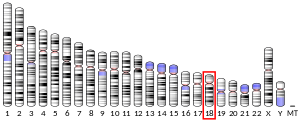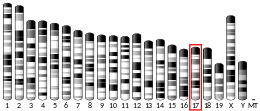NDUFV2
| NDUFV2 | |||||||||||||||||||||||||||||||||||||||||||||||||||
|---|---|---|---|---|---|---|---|---|---|---|---|---|---|---|---|---|---|---|---|---|---|---|---|---|---|---|---|---|---|---|---|---|---|---|---|---|---|---|---|---|---|---|---|---|---|---|---|---|---|---|---|
| Identifiers | |||||||||||||||||||||||||||||||||||||||||||||||||||
| Aliases | NDUFV2, CI-24k, NADH:ubiquinone oxidoreductase core subunit V2, MC1DN7 | ||||||||||||||||||||||||||||||||||||||||||||||||||
| External IDs | OMIM: 600532; MGI: 1920150; HomoloGene: 10884; GeneCards: NDUFV2; OMA:NDUFV2 - orthologs | ||||||||||||||||||||||||||||||||||||||||||||||||||
| |||||||||||||||||||||||||||||||||||||||||||||||||||
| |||||||||||||||||||||||||||||||||||||||||||||||||||
| |||||||||||||||||||||||||||||||||||||||||||||||||||
| |||||||||||||||||||||||||||||||||||||||||||||||||||
| |||||||||||||||||||||||||||||||||||||||||||||||||||
| Wikidata | |||||||||||||||||||||||||||||||||||||||||||||||||||
| |||||||||||||||||||||||||||||||||||||||||||||||||||
NADH dehydrogenase [ubiquinone] flavoprotein 2, mitochondrial (NDUFV2) is an enzyme that in humans is encoded by the NDUFV2 gene.[5][6] The encoded protein, NDUFV2, is a subunit of complex I of the mitochondrial respiratory chain, which is located on the inner mitochondrial membrane and involved in oxidative phosphorylation. Mutations in this gene are implicated in Parkinson's disease, bipolar disorder, schizophrenia, and have been found in one case of early onset hypertrophic cardiomyopathy and encephalopathy.[7]
Structure
[edit]NDUFV2 is located on the p arm of chromosome 18 in position 11.22 and has 9 exons.[7] The NDUFV2 gene produces a 27.4 kDa protein composed of 249 amino acids.[8][9] NDUFV2, the protein encoded by this gene, is a member of the complex I 24 kDa subunit family. It contains a cofactor binding site for a 2Fe-2S cluster and a transit peptide domain. The protein consists of 2 turns, 3 beta strands, and 7 alpha helixes.[10][11] A non-transcribed pseudogene of this locus is found on chromosome 19.[7]
Function
[edit]The NADH-ubiquinone oxidoreductase complex (complex I) of the mitochondrial respiratory chain catalyzes the transfer of electrons from NADH to ubiquinone, and consists of at least 43 subunits. The complex is located in the inner mitochondrial membrane. This gene encodes the 24 kDa subunit of complex I, and is involved in electron transfer.[7] NDUFV2 is an oxidoreductase and a component of the flavoprotein-sulfur (FP) fragment of the enzyme.[12] It is thought to be required for assembly and catalysis.[10][11]
Catalytic activity
[edit]NADH + ubiquinone + 5 H+(In) = NAD+ + ubiquinol + 4 H+(Out).
NADH + acceptor = NAD+ + reduced acceptor.[10][11]
Clinical significance
[edit]Mutations in the NDUFV2 gene are associated with Mitochondrial Complex I Deficiency, which is autosomal recessive. This deficiency is the most common enzymatic defect of the oxidative phosphorylation disorders.[13][14] Mitochondrial complex I deficiency shows extreme genetic heterogeneity and can be caused by mutation in nuclear-encoded genes or in mitochondrial-encoded genes. There are no obvious genotype–phenotype correlations, and inference of the underlying basis from the clinical or biochemical presentation is difficult, if not impossible.[15] However, the majority of cases are caused by mutations in nuclear-encoded genes.[16][17] It causes a wide range of clinical disorders, ranging from lethal neonatal disease to adult-onset neurodegenerative disorders. Phenotypes include macrocephaly with progressive leukodystrophy, nonspecific encephalopathy, hypertrophic cardiomyopathy, myopathy, liver disease, Leigh syndrome, Leber hereditary optic neuropathy, and some forms of Parkinson disease.[18]
Interactions
[edit]NDUFV2 has been shown to have 102 binary protein-protein interactions including 80 co-complex interactions. NDUFV2 appears to interact with HSCB, CCNC, GOLM1, FAM114A2, CRMP1, KAT5, SP110.[19]
References
[edit]- ^ a b c GRCh38: Ensembl release 89: ENSG00000178127 – Ensembl, May 2017
- ^ a b c GRCm38: Ensembl release 89: ENSMUSG00000024099 – Ensembl, May 2017
- ^ "Human PubMed Reference:". National Center for Biotechnology Information, U.S. National Library of Medicine.
- ^ "Mouse PubMed Reference:". National Center for Biotechnology Information, U.S. National Library of Medicine.
- ^ Emahazion T, Beskow A, Gyllensten U, Brookes AJ (Nov 1998). "Intron based radiation hybrid mapping of 15 complex I genes of the human electron transport chain". Cytogenetics and Cell Genetics. 82 (1–2): 115–9. doi:10.1159/000015082. PMID 9763677. S2CID 46818955.
- ^ de Coo R, Buddiger P, Smeets H, Geurts van Kessel A, Morgan-Hughes J, Weghuis DO, Overhauser J, van Oost B (April 1995). "Molecular cloning and characterization of the active human mitochondrial NADH:ubiquinone oxidoreductase 24-kDa gene (NDUFV2) and its pseudogene". Genomics. 26 (3): 461–6. doi:10.1016/0888-7543(95)80163-G. PMID 7607668. S2CID 6919815.
- ^ a b c d "Entrez Gene: NDUFV2 NADH dehydrogenase (ubiquinone) flavoprotein 2, 24kDa".
 This article incorporates text from this source, which is in the public domain.
This article incorporates text from this source, which is in the public domain.
- ^ Yao, Daniel. "Cardiac Organellar Protein Atlas Knowledgebase (COPaKB) —— Protein Information". amino.heartproteome.org. Retrieved 2018-08-27.
- ^ Zong NC, Li H, Li H, Lam MP, Jimenez RC, Kim CS, Deng N, Kim AK, Choi JH, Zelaya I, Liem D, Meyer D, Odeberg J, Fang C, Lu HJ, Xu T, Weiss J, Duan H, Uhlen M, Yates JR, Apweiler R, Ge J, Hermjakob H, Ping P (October 2013). "Integration of cardiac proteome biology and medicine by a specialized knowledgebase". Circulation Research. 113 (9): 1043–53. doi:10.1161/CIRCRESAHA.113.301151. PMC 4076475. PMID 23965338.
- ^ a b c "NDUFV2 - NADH dehydrogenase [ubiquinone] flavoprotein 2, mitochondrial precursor - Homo sapiens (Human) - NDUFV2 gene & protein". www.uniprot.org. Retrieved 2018-08-27.
 This article incorporates text available under the CC BY 4.0 license.
This article incorporates text available under the CC BY 4.0 license.
- ^ a b c "UniProt: the universal protein knowledgebase". Nucleic Acids Research. 45 (D1): D158 – D169. January 2017. doi:10.1093/nar/gkw1099. PMC 5210571. PMID 27899622.
- ^ Murray J, Zhang B, Taylor SW, Oglesbee D, Fahy E, Marusich MF, Ghosh SS, Capaldi RA (April 2003). "The subunit composition of the human NADH dehydrogenase obtained by rapid one-step immunopurification". The Journal of Biological Chemistry. 278 (16): 13619–22. doi:10.1074/jbc.C300064200. PMID 12611891.
- ^ Kirby DM, Salemi R, Sugiana C, Ohtake A, Parry L, Bell KM, Kirk EP, Boneh A, Taylor RW, Dahl HH, Ryan MT, Thorburn DR (September 2004). "NDUFS6 mutations are a novel cause of lethal neonatal mitochondrial complex I deficiency". The Journal of Clinical Investigation. 114 (6): 837–45. doi:10.1172/JCI20683. PMC 516258. PMID 15372108.
- ^ McFarland R, Kirby DM, Fowler KJ, Ohtake A, Ryan MT, Amor DJ, Fletcher JM, Dixon JW, Collins FA, Turnbull DM, Taylor RW, Thorburn DR (January 2004). "De novo mutations in the mitochondrial ND3 gene as a cause of infantile mitochondrial encephalopathy and complex I deficiency". Annals of Neurology. 55 (1): 58–64. doi:10.1002/ana.10787. PMID 14705112. S2CID 21076359.
- ^ Haack TB, Haberberger B, Frisch EM, Wieland T, Iuso A, Gorza M, Strecker V, Graf E, Mayr JA, Herberg U, Hennermann JB, Klopstock T, Kuhn KA, Ahting U, Sperl W, Wilichowski E, Hoffmann GF, Tesarova M, Hansikova H, Zeman J, Plecko B, Zeviani M, Wittig I, Strom TM, Schuelke M, Freisinger P, Meitinger T, Prokisch H (April 2012). "Molecular diagnosis in mitochondrial complex I deficiency using exome sequencing" (PDF). Journal of Medical Genetics. 49 (4): 277–83. doi:10.1136/jmedgenet-2012-100846. PMID 22499348. S2CID 3177674.
- ^ Loeffen JL, Smeitink JA, Trijbels JM, Janssen AJ, Triepels RH, Sengers RC, van den Heuvel LP (2000). "Isolated complex I deficiency in children: clinical, biochemical and genetic aspects". Human Mutation. 15 (2): 123–34. doi:10.1002/(SICI)1098-1004(200002)15:2<123::AID-HUMU1>3.0.CO;2-P. PMID 10649489. S2CID 35579133.
- ^ Triepels RH, Van Den Heuvel LP, Trijbels JM, Smeitink JA (2001). "Respiratory chain complex I deficiency". American Journal of Medical Genetics. 106 (1): 37–45. doi:10.1002/ajmg.1397. PMID 11579423.
- ^ Robinson BH (May 1998). "Human complex I deficiency: clinical spectrum and involvement of oxygen free radicals in the pathogenicity of the defect". Biochimica et Biophysica Acta (BBA) - Bioenergetics. 1364 (2): 271–86. doi:10.1016/s0005-2728(98)00033-4. PMID 9593934.
- ^ "102 binary interactions found for search term NDUFV2". IntAct Molecular Interaction Database. EMBL-EBI. Retrieved 2018-08-27.
Further reading
[edit]- Pilkington SJ, Walker JE (April 1989). "Mitochondrial NADH-ubiquinone reductase: complementary DNA sequences of import precursors of the bovine and human 24-kDa subunit". Biochemistry. 28 (8): 3257–64. doi:10.1021/bi00434a021. PMID 2500970.
- Hattori N, Suzuki H, Wang Y, Minoshima S, Shimizu N, Yoshino H, Kurashima R, Tanaka M, Ozawa T, Mizuno Y (November 1995). "Structural organization and chromosomal localization of the human nuclear gene (NDUFV2) for the 24-kDa iron-sulfur subunit of complex I in mitochondrial respiratory chain". Biochemical and Biophysical Research Communications. 216 (3): 771–7. doi:10.1006/bbrc.1995.2688. PMID 7488192.
- Hattori N, Yoshino H, Tanaka M, Suzuki H, Mizuno Y (April 1998). "Genotype in the 24-kDa subunit gene (NDUFV2) of mitochondrial complex I and susceptibility to Parkinson disease". Genomics. 49 (1): 52–8. doi:10.1006/geno.1997.5192. PMID 9570948.
- Loeffen JL, Triepels RH, van den Heuvel LP, Schuelke M, Buskens CA, Smeets RJ, Trijbels JM, Smeitink JA (December 1998). "cDNA of eight nuclear encoded subunits of NADH:ubiquinone oxidoreductase: human complex I cDNA characterization completed". Biochemical and Biophysical Research Communications. 253 (2): 415–22. doi:10.1006/bbrc.1998.9786. PMID 9878551.
- Bénit P, Beugnot R, Chretien D, Giurgea I, De Lonlay-Debeney P, Issartel JP, Corral-Debrinski M, Kerscher S, Rustin P, Rötig A, Munnich A (June 2003). "Mutant NDUFV2 subunit of mitochondrial complex I causes early onset hypertrophic cardiomyopathy and encephalopathy". Human Mutation. 21 (6): 582–6. doi:10.1002/humu.10225. PMID 12754703. S2CID 19514743.
- Washizuka S, Kakiuchi C, Mori K, Kunugi H, Tajima O, Akiyama T, Nanko S, Kato T (July 2003). "Association of mitochondrial complex I subunit gene NDUFV2 at 18p11 with bipolar disorder". American Journal of Medical Genetics. Part B, Neuropsychiatric Genetics. 120B (1): 72–8. doi:10.1002/ajmg.b.20041. PMID 12815743. S2CID 10851458.
- Washizuka S, Iwamoto K, Kazuno AA, Kakiuchi C, Mori K, Kametani M, Yamada K, Kunugi H, Tajima O, Akiyama T, Nanko S, Yoshikawa T, Kato T (October 2004). "Association of mitochondrial complex I subunit gene NDUFV2 at 18p11 with bipolar disorder in Japanese and the National Institute of Mental Health pedigrees". Biological Psychiatry. 56 (7): 483–9. doi:10.1016/j.biopsych.2004.07.004. PMID 15450783. S2CID 35140676.
- Stelzl U, Worm U, Lalowski M, Haenig C, Brembeck FH, Goehler H, Stroedicke M, Zenkner M, Schoenherr A, Koeppen S, Timm J, Mintzlaff S, Abraham C, Bock N, Kietzmann S, Goedde A, Toksöz E, Droege A, Krobitsch S, Korn B, Birchmeier W, Lehrach H, Wanker EE (September 2005). "A human protein-protein interaction network: a resource for annotating the proteome". Cell. 122 (6): 957–68. doi:10.1016/j.cell.2005.08.029. hdl:11858/00-001M-0000-0010-8592-0. PMID 16169070. S2CID 8235923.
- Washizuka S, Kametani M, Sasaki T, Tochigi M, Umekage T, Kohda K, Kato T (April 2006). "Association of mitochondrial complex I subunit gene NDUFV2 at 18p11 with schizophrenia in the Japanese population". American Journal of Medical Genetics. Part B, Neuropsychiatric Genetics. 141B (3): 301–4. doi:10.1002/ajmg.b.30285. PMID 16508936. S2CID 34154064.
This article incorporates text from the United States National Library of Medicine, which is in the public domain.





